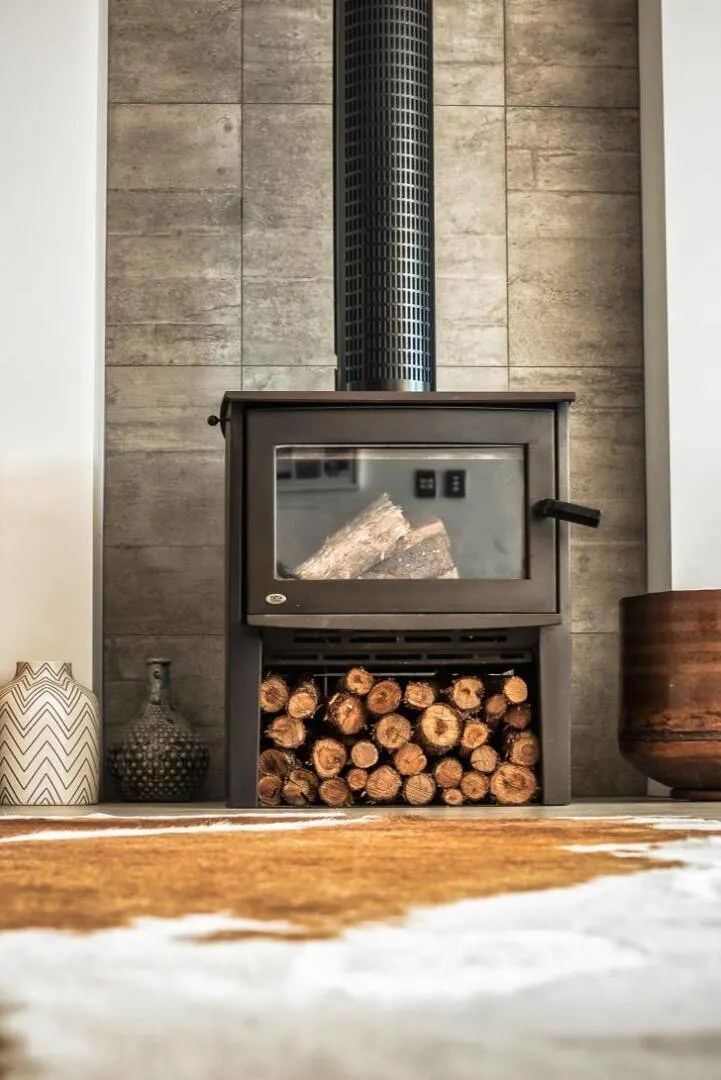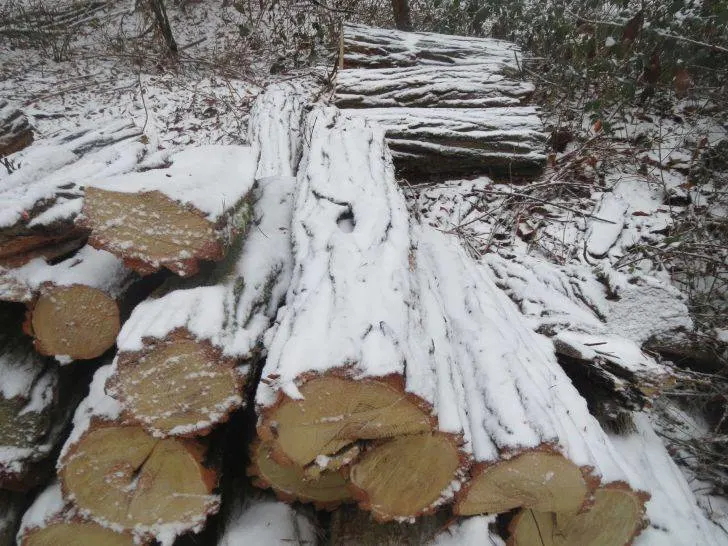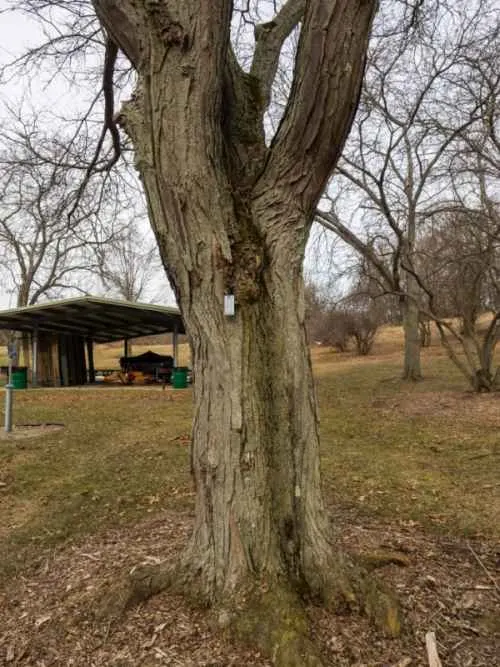You must consider certain factors while choosing the right firewood. Some of these essential factors include heat output, burn time, smoke emissions, and overall efficiency.
One popular option for firewood is the locust. If you have never used locust wood for burning, you might wonder if it is good or not.
So, is locust good firewood?
Locust wood has been gaining popularity as firewood thanks to its unique qualities. If you are looking into locust wood as a suitable option for firewood, this article will help you explore more about it.
Let’s begin!

Is Locust Good Firewood?
Yes! Locusts are good firewood.
It is because of its several great qualities, such as:
- It burns for a long time with little smoke.
- It is easy to use, split, and store.
- It is an eco-friendly choice.
All these characteristics and more make locusts an excellent option for firewood.
Now that you know the answer to your question, let’s dig deeper into some of the qualities that make the locust a great firewood.
Characteristics of Locust Wood!
Locust trees are known for being strong and long-lasting; some of the top characteristics that make locusts good firewood are:
High Energy Content and Heat Output
Locust wood is known for its high energy content, which can produce significant heat when burned, making it an excellent choice for heating, ensuring a warm and cozy environment during colder seasons.
The dense composition of locust wood allows for efficient combustion, maximizing the heat output and providing effective warmth.

Long Burn Time and Sustained Heat
One of the notable characteristics of locust wood is its long burn time.
When properly seasoned and dry, locust wood can burn for an extended period, providing sustained heat without frequent refueling.
This quality is advantageous for maintaining a consistent and comfortable temperature, especially during overnight heating or when continuous warmth is desired.
Low Smoke Emission
Locust wood, when adequately seasoned, produces minimal smoke during combustion.
Compared to other types of firewood, locust wood emits lower levels of smoke, reducing the chances of smoke-related discomfort and health issues.
This characteristic contributes to a more pleasant fire experience and makes locust wood a more environmentally friendly choice.
Minimal Sparks
When burning locust wood, there is a reduced risk of sparks compared to other firewood types.
The wood’s composition and density generate fewer sparks, making it safer for indoor fireplaces or wood-burning stoves. This minimizes the risk of accidental fires and enhances the safety of using locust wood as firewood.

Hardwood and Easy to Ignite
Locust wood belongs to the hardwood category, which burns longer and produces more heat than softwood.
Despite its classification as hardwood, locust wood is easy to ignite, making it convenient to start a fire and maintain a steady flame, providing efficient heat and a comfortable atmosphere.
Resistance to Decay and Insect Infestation
Locust wood is known for its natural resistance to decay and insect infestation.
The dense and durable nature of locust wood makes it less susceptible to rotting and damage caused by wood-boring insects.
This resistance ensures that the firewood remains intact and usable for an extended period, making locust wood a reliable and long-lasting option.

Types of Locusts Trees Used for Firewood!
There are two most common types of locust trees used for firewood which are:
- Black locust wood
- Honey locust wood
Let’s look at both.
Black Locust Wood
Black Locust (Robinia pseudoacacia) is one of the best locust trees for firewood use.
It is a hardwood tree native to North America, typically growing in the Eastern and Central United States.
It is a tall, fast-growing tree with an upright, straight trunk and an evenly spaced branching habit. It has a high BTU rating and a low moisture content, making it an excellent choice for an efficient, long-lasting fire.
It also has a pleasant aroma and is an easy-to-split wood.

Honey Locust Wood
Honey Locust (Gleditsia triacanthos) is a medium-sized deciduous tree native to North America.
It is known for its beautiful yellow-green foliage and long, dark thorns that can reach up to five inches long.
The wood of this species is strong and durable.
Honey locust wood is excellent firewood for burning. It has a high heat value rating of 26.7 million BTU/cord and is a clean-burning hardwood that produces minimal sparks and smoke.
As a hardwood, it also burns slowly and steadily, making it an excellent choice for extended fires.

Advantages of Using Locusts as Firewood!
The following are some of the top benefits of using locusts as firewood.
High Energy Efficiency
Locust wood boasts excellent energy efficiency, meaning it can convert a significant amount of its stored energy into heat when burned. This translates into a more effective and economical use of firewood, as less wood is required to produce the desired level of warmth.
Rapid Seasoning and Drying Time
Locust wood has the advantage of seasoning and drying relatively quickly compared to other hardwood varieties.
The shorter drying time allows for faster preparation and use of the firewood, ensuring a readily available and accessible heat source.
Pleasant Aroma
When burned, locust wood emits a pleasant and distinctive aroma, adding to the overall enjoyment of the fire experience.
The aromatic qualities of locust wood can enhance the ambiance and create a cozy atmosphere, making it particularly appealing for indoor fireplaces or gatherings around an outdoor fire pit.
Availability and Sustainability of Locust Wood
Locust trees are abundant in many regions, making locust wood readily available as a firewood source.
Its availability contributes to its popularity as a sustainable choice for heating purposes.
With proper management and responsible harvesting, locust wood can be sustainably obtained, reducing the environmental impact, and ensuring a renewable supply of firewood.
Considerations and Potential Challenges!
Here are some potential challenges you may face in using locusts as firewood.
Difficulty in Splitting and Handling Locust Wood
One of the challenges of working with locust wood is its hardness, making it more difficult to split than softer wood.
The dense nature of locust wood requires extra effort and suitable tools for effective splitting.
A heavy-duty axe or a hydraulic log splitter can help overcome this challenge.
Additionally, the weight of locust firewood can pose challenges during handling and transportation, especially for individuals with physical limitations. Proper lifting techniques should be employed to prevent strain or injury when dealing with heavy locust logs.
Prone to Forming Heavy Smoke If Not Properly Seasoned
Locust wood, like any firewood, must be properly seasoned before use.
Failure to adequately dry and season locust wood can result in the formation of heavy smoke during combustion. High moisture content in the wood leads to incomplete burning and increased smoke emission.
It is essential to allow sufficient time for locust wood to be dry, typically around six months to a year, depending on the climate and initial moisture content. Properly seasoned locust wood will reduce smoke production, improve burn efficiency, and heat output.
Need for Adequate Storage and Drying Time
Locust wood requires appropriate storage conditions and ample drying time for optimal performance. Stacking and storing the wood in a well-ventilated area with good airflow is important.
Regional Availability and Pricing Variations
The availability of locust wood can vary depending on different regions.
Locust trees may be more prevalent in certain areas and less common or absent in others. It is important to research and identify reliable sources of locust wood in your local area.
Additionally, the pricing of locust firewood can be influenced by factors such as availability, demand, and local market conditions.
Preparation and Storage of Locust Firewood!
Here are some ways to safely store locusts:
Proper Seasoning Techniques for Locust Wood
Locust wood should be properly seasoned before use to ensure optimal performance and efficiency.
Seasoning involves reducing the moisture content of the wood through a drying process.
Start by cutting the locust wood into manageable lengths and splitting it into smaller pieces to accelerate the drying process. Place the split wood in a well-ventilated area with good airflow and allow it to dry for at least six months to a year, depending on the climate and moisture content.
Importance of Moisture Content and Drying Time
The moisture content of locust wood significantly affects its burn quality and efficiency.
Ideally, locust firewood should have a moisture content of around 20% or less for optimal performance.
This ensures cleaner combustion, reduced smoke, and increased heat output.
It’s essential to monitor the moisture content using a moisture meter before using the wood to ensure it is adequately dried.
Stacking And Storing Locust Firewood
Stacking and storing locust firewood is crucial for maintaining its quality and usability. Start by creating a raised platform or using pallets to keep the wood off the ground, allowing airflow underneath and preventing moisture absorption.
Stack the split locust wood neatly and stably, leaving spaces between the pieces to facilitate airflow and further drying. Cover the top of the stack with a waterproof tarp or cover to protect it from rain or snow while still allowing proper ventilation.
4 Best Techniques to Stack and Store Firewood – Bright Ideas: Episode 4 – YouTube
Tips for Efficient and Safe Use of Locust Firewood!
When using locust firewood, following some essential tips for efficiency and safety is paramount.
- First, always burn well-seasoned locust wood to ensure optimal heat output and minimize smoke emissions.
- Avoid burning green or wet wood, leading to poor combustion and creosote buildup.
- Additionally, practice regular chimney or flue cleaning to prevent the accumulation of soot and creosote, which can pose a fire hazard.
- Finally, remember to maintain proper ventilation during indoor use to ensure good airflow and minimize the risk of carbon monoxide buildup.
That’s all for today.
Let’s move toward the conclusion.
Conclusion!
Overall, locusts are excellent firewood.
It has several attributes to its name that make it a good option for burning. Its top characteristics include high energy efficiency, low smoke, disease resistance, eco-friendliness, sustainability, etc.
It is one of the better options out there. However, you may face some challenges in using locusts as firewood.
Follow all the tips given above, and you will be able to resolve those hurdles.
Regards.
